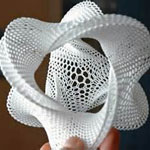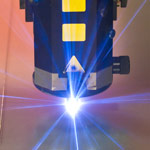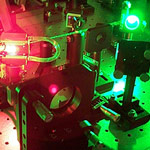PolarOnyx's proprietary technology on advanced ultrafast lasers based 3D manufacturing (Additive Manufacturing and Subtractive Manufacturing) opens a variety of opportunities in many fast-growing industries like aerospace, defense, bio-medicals, sensors, and communications.
The unique competitive advantages of the technology provide PolarOnyx with the capability of developing laser 3D manufacturing products, which are maintenance-free and cost-effective for both industrial and scientific applications.

|
1. 3D Laser Manufacturing3D printing/additive manufacturing has attracted significant attention over the last decade and it can create complex parts that are difficult to be manufactured traditionally. Compared with conventional laser AM techniques (thermally melted welding), the fs fiber laser AM offers many advantages including localized high temperature heating, manipulating microstructures and macrostructures, uniform mixing of dissimilar materials, limited HAZ, and stable sub-micron grain structure. It is the ideal solution for 3D manufacturing of high temperature materials and fine structures. Moreover, subtractive manufacturing (SM) can be naturally integrated to make hybrid (AM and SM) process by using fs fiber laser. |

|
2. Nonlinear Imaging and MicroscopyOur femtosecond fiber lasers provide vital tools for nonlinear biomedical imaging such as multi-photon imaging (MPI) and Coherent Anti-Stoke Raman Spectroscopic (CARS) microscopy. Our supercontinuum fiber lasers provide a wide bandwidth (over 2000 nm) enabling Optical Coherent Tomography (OCT) and wavelength tunable microscopy. |

|
3. Micromachining and MicrostructuringHigh energy and high power femtosecond fiber lasers are ideal ultrafast laser products for a series of micromachining and microstructuring applications, such as waveguide writing, microfluidic channeling, Silicon scribing, components/parts marking, hole drilling, etc.. Compared with long pulsed laser, femtosecond fiber lasers provides less heat affected zone (HAZ), finer feature (micron and sub-micron), and higher quality. |

|
4. Tissue Ablation and Micro & Nano SurgerySubcellular laser ablation (SLA) has emerged as a powerful tool for the measurement of mechanical properties of load-bearing cytoskeletal elements in their living, intracellular context. In SLA, high-energy laser pulses of ultrashort (100 fs) duration are focused through a high-numerical-aperture objective lens onto an intracellular target such as an organelle or a cytoskeletal element. Using an ultrashort pulse, material at the laser focus undergoes nonlinear multiphoton absorption leading to optical breakdown and material destruction with minimal heat transfer or collateral damage to surrounding structures. |

|
5. Precision Optical Comb and SpectroscopySupercontinuum mode-locked fiber lasers can simultaneously generates hundreds of thousands sharp (highly coherent) spectral components evenly distributed over 1000 nm of spectral bandwidth to detect a wide array of molecules and key isotopologues via IR absorption spectroscopy. This optical frequency comb (OFC) or supercontinuum (SC) can probe overtone vibrations of molecular bonds, including the stretching of C-H, N-H, O-H, and S-H bonds. It can detect CH4, O3, H2O, CO2, CO, H2S, N2O, NH3, HCN, C2H2, C6H6 (benzene) and many other volatile compounds. In analogy with a mechanical clockwork, an optical clockwork is a device which phase-coherently relates a high and a low frequency and can serve as a central ingredient of an optical clock. An optical frequency from some frequency standard (e.g. a single ion in a Paul trap) can then be expressed by the sum of the carrier–envelope offset frequency, a certain integer multiple of the pulse repetition frequency, and a beat note frequency, which can all be measured and processed with fast electronics. It is thus possible to phase-coherently compare the frequencies of the optical standard and a cesium clock and correct the timing signal of the latter, |

|
6. Defense and AerospaceOptical sensing (such as Lidar and Ladar) and optical communications requires compact, robust and efficient fiber lasers. PolarOnyx's fiber lasers provide all the features meeting customer's needs. By integrating PolarOnyx’s fiber lasers with OPO/OPA, various mid-IR laser source can be generated for countermeasure applications. |

|
7. Optical Fiber CommunicationsOur newly developed compact GHz (1 -100 GHz) mode locked fiber lasers enable next generation high speed fiber communications in a cost-effective way. |

